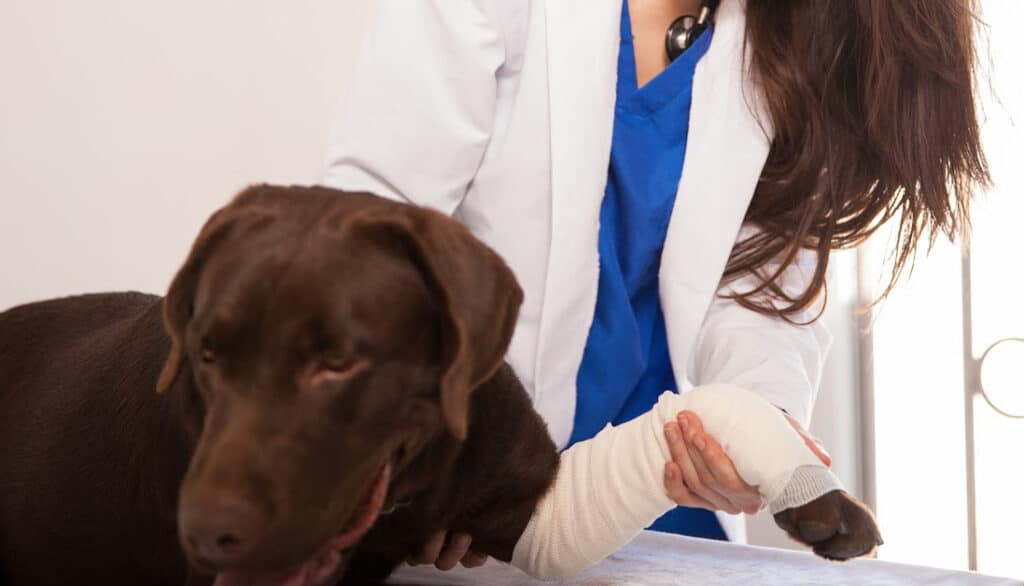The Instinct to Put A Bandaid On Your Dog: A Common Scenario
It’s a typical afternoon, and you’re playing fetch with your furry best friend. Suddenly, he steps on a sharp object, lets out a yelp, and starts to limp. Your heart sinks as you rush over to examine his paw.
There’s a small cut on the pad of his foot that’s barely bleeding, but it looks painful. What do you do?
Many pet owners’ instinct is to put a bandaid on their dog’s injury – after all, it’s what we’ve been taught since childhood for our human cuts and scrapes. However, when it comes to our four-legged companions, the idea of using bandages is often debated among pet owners and veterinarians.
On the one hand, bandaids can be helpful for certain injuries such as small cuts or abrasions – they can protect the wound from dirt and bacteria while also promoting healing. On the other hand, dogs are naturally curious creatures who like to lick or chew at anything that doesn’t belong on their bodies – including bandages!
This can sometimes cause more harm than good by preventing proper healing or leading to infection. This topic presents several questions – Can I put a bandaid on my dog? The short answer is yes, but it’s not the best option.
Is it always necessary? Are there situations where it may do more harm than good?
In this article, we’ll explore these questions in-depth so that you feel confident in making informed decisions about your pet’s health and well-being. So grab your furry friend and let’s dive in!

Can you put a bandaid on your dog?
As pet owners, we want to do everything we can to protect our furry friends. So, when they get injured, our first instinct may be to slap a bandaid on the wound and call it a day.
But is this really the best course of action? Let’s take a look at the pros and cons of using a bandaid on dogs.
The Pros
For minor injuries like small cuts or scrapes, a bandaid can be an effective way to keep the wound clean and protected from bacteria. It can also help prevent your dog from licking or biting at the injury, which can slow down healing time. Plus, seeing your dog in a cute little bandage can just make you feel better about their injury.
The Cons
On the other hand, there are some potential downsides to using a bandage on your pup. For one thing, dogs have fur and their skin isn’t flat like ours. This means that it can be difficult to get the adhesive of the bandaid to stick properly. This could cause the bandage to fall off or move around, which could actually irritate the injury further.
Additionally, if you’re not careful about keeping the area clean and dry underneath the bandage, it could actually trap bacteria next to your dog’s skin and make things worse. Your dog may get too curious about their new accessory and starts chewing or scratching at it. They could end up swallowing pieces of adhesive or even ingesting part of the actual bandage.

When should you consider using a bandage?
In general, small cuts or abrasions that are shallow enough for a regular old human-sized bandaid should be fine for dogs as well (assuming they don’t try to rip it off). It’s important though that before applying a bandaid, you clean the wound thoroughly to avoid any potential infections.
However, keep in mind that for larger or more serious injuries, a bandaid may not be effective or necessary. In these cases, it’s best to seek veterinary care right away – your dog may need stitches or other medical attention beyond what a simple bandage can provide.
Overall, using a bandaid on your dog can be both helpful and potentially harmful depending on the situation. It’s important to weigh the pros and cons and assess whether it’s really necessary for your pet’s specific injury.
When to Use a Bandaid on Your Dog
The Benefits of Using a Bandage
As a pet owner, you want to keep your furry friend as safe and comfortable as possible. In some cases, using a bandage can help protect minor wounds and promote healing. Small cuts or abrasions are common among dogs, especially those who live an active lifestyle.
These types of injuries can be easily sustained during playtime or while out on walks. However, not all cuts require a bandage – it depends on the severity of the injury.
For example, if your dog has a deep wound or puncture, it’s best to seek veterinary care rather than attempting to bandage it yourself. But for minor scrapes and cuts, using a bandage can help prevent dirt and bacteria from entering the wound.

How to Properly Clean and Dress the Wound
Before applying a bandage to your dog’s wound, you need to clean and dress it properly. Start by washing your hands with soap and water – this will prevent any unwanted bacteria from getting into the wound.
Then, use warm water or saline solution to clean the affected area. If there is debris in the wound (such as dirt or gravel), use sterile tweezers to carefully remove it.
Be gentle so as not to cause further damage to the skin. Next, apply an antiseptic solution (such as hydrogen peroxide) or antibiotic ointment onto the wound with sterile gauze or cotton balls.
This will help kill any remaining bacteria that may cause infection. Once you’ve cleaned and disinfected the wound, you’re ready for dressing!
Cut off an appropriately sized piece of gauze pad that can fully cover the injury site (it’s better if you have non-stick gauze). The next step is wrapping that gauze pad around with adhesive tape – make sure it’s not too tight as it may cause further injury, so you can easily slide your finger under the bandage.
Things to Keep in Mind
It’s important to note that while using a bandage can be helpful for minor wounds, it’s not always necessary. In some cases, letting the wound breathe and heal on its own may be more effective. Keep an eye on your dog’s behavior – if they seem uncomfortable or are constantly trying to remove the bandage, it may be best to remove it entirely.
In addition, make sure to change the bandage regularly (usually every 1-2 days) and monitor the healing process. If you notice any signs of infection (such as swelling or redness), contact your vet immediately.
Overall, using a bandage on your dog can be a helpful way to promote healing and protect minor injuries. However, it’s important to properly clean and dress the wound before applying a bandage and to always monitor your dog for any signs of discomfort or infection.

When Not to Use a Bandaid on Your Dog
Why Bandaging Deep Wounds or Punctures is Not Recommended
While bandages can be useful for minor cuts or scrapes, it’s important to realize that they are not always the best solution for every type of injury. In fact, using a bandage to treat deep wounds or punctures may actually do more harm than good. This is because these types of injuries often require more advanced medical treatment to prevent infection and promote healing.
Deep wounds or punctures can easily become infected by bacteria, dirt, and debris that gets trapped in the wound. When you place a bandage over the wound, you create an environment that is ideal for bacteria to thrive and multiply.
This can lead to serious infections that require extensive medical attention. In addition to increasing the risk of infection, using a bandage on deep wounds or punctures may also delay proper treatment.
Instead of covering up the injury with a bandage, it’s important to seek veterinary care right away. This will ensure that your dog receives the necessary medical attention and treatments required for proper healing.
The Importance of Seeking Veterinary Care for Serious Injuries
It’s crucial not to underestimate the severity of certain injuries your dog might sustain. Often times when our furry friends are injured we want nothing more than to help them feel better and put our minds at ease by placing a simple solution like a standard adhesive strip from our first aid kit without thinking much about it.
However, some injuries might be far worse than we think they are just by simply looking at them from the outside; this is where veterinary care comes into play. A qualified veterinarian has been professionally trained in diagnosing animal injuries and providing proper medical attention needed at each stage of recovery.
Seeking veterinary care as soon as possible after an injury will increase your dog’s likelihood of full recovery. Your vet will check your dog over thoroughly to detect any underlying issues and properly diagnose the severity of the injury.

The Alternative for Treating Deep Wounds or Punctures
If your dog suffers from a deep wound or puncture, it’s important to follow certain steps before seeking veterinary care. First and foremost, clean the wound with mild soapy water and rinse gently but thoroughly with warm water once the debris has been removed. Do not use alcohol, hydrogen peroxide or iodine on wounds as this may damage healthy tissue surrounding the injury.
After cleaning the wound dress it with a non-adhesive dressing such as sterile gauze under which you can place an absorbent sanitary pad to keep it in place. Secure this dressing with adhesive tape, making sure it’s not too tight but snug enough that it stays in place.
It’s important to monitor your pet closely throughout their recovery, ensuring that no signs of infection occur such as discolouration of skin around the injury site, foul discharge from wound meanonskin or fever. Should you notice any changes seek veterinary attention immediately.
Alternatives to Using a Bandaid on Your Dog
The Elizabethan Collar
One of the most effective alternatives to using a bandaid on your dog is the Elizabethan collar. Also known as an e-collar or cone, this device fits around your dog’s neck and prevents them from licking or biting at an injury. This can be especially helpful for injuries that are difficult to bandage, such as those on the face or head.
E-collars come in various sizes and materials, and can be purchased at most pet stores or online. While some dogs may initially struggle with wearing an e-collar, it is important for their own safety and healing process.
After all, licking or biting at a wound can introduce bacteria and delay healing. To help your dog adjust to wearing an e-collar, try positive reinforcement techniques such as offering treats and praise when they wear it without fussing.

Gauze and Tape
Another alternative to using a bandaid on your dog is covering the injury with gauze and tape. This method is particularly useful for larger injuries that cannot be fully covered with a bandage.
To do this, first clean the wound thoroughly with soap and water or an antiseptic spray. Then cover the wound with sterile gauze (or non-stick pads) and secure it in place using medical tape.
It’s important to make sure that the gauze isn’t too tight around your dog’s skin – you should still be able to fit two fingers between the gauze and their skin comfortably. Change the dressing daily (or more frequently if it becomes dirty or wet) until the wound has fully healed.
Natural Remedies
If you’re looking for a more natural approach to promoting healing for your dog’s injury, there are several remedies you can try. One of the most effective is raw honey, which has antibacterial and anti-inflammatory properties.
Simply apply a small amount of honey directly to the wound (after cleaning it) and cover with gauze or a light bandage. Another natural remedy that can help promote healing is coconut oil.
This versatile oil can be used both topically and orally for dogs, and contains lauric acid, which has antimicrobial properties. You can apply coconut oil directly to the wound or add a small amount to your dog’s food for added health benefits.
While natural remedies may not be suitable for all injuries or situations, they can be a helpful addition to traditional treatments. As always, consult with your veterinarian before trying any new remedies or treatments for your dog’s injury.
The use of band-aids or any other form of dressing on your dog depends on the nature and severity of the wound. While some injuries may require a bandage to help with healing, others may not.
The most important thing is to keep your dog comfortable, prevent further injury, and promote healing. If you’re considering using a band-aid on your dog, it’s vital to understand that not all wounds can be effectively treated using this method.
In many cases, particularly deeper wounds and punctures, bandaging may do more harm than good. It’s always better to err on the side of caution and seek veterinary care for significant injuries.
Alternatives such as Elizabethan collars or covering with gauze and tape can be helpful if your dog doesn’t need a full-on band-aid. Natural remedies such as honey or coconut oil can also aid in promoting healing when used appropriately.

Conclusion
The bottom line is that when it comes to caring for our furry friends, we should always be mindful of their well-being and seek expert advice when necessary. When in doubt about whether or not to use a band-aid on your dog, it’s best practice to consult with a veterinarian who will determine the appropriate course of treatment for your pet’s particular injury.
By doing so, you’ll ensure that your faithful companion receives proper care while also avoiding any potential complications that could arise from improper treatment methods. Remember: taking care of our pets is our utmost priority!
